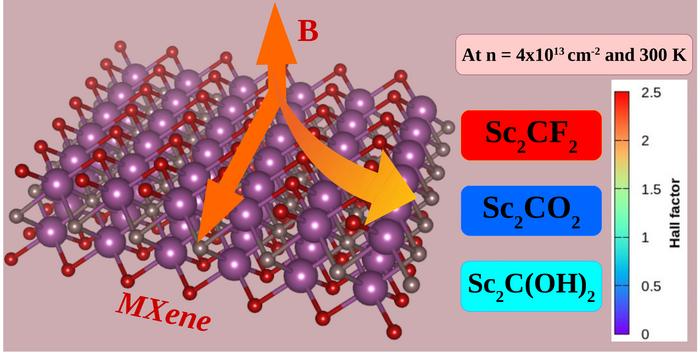A team of researchers, led by Seung-Cheol Lee, Director of the Indo-Korea Science and Technology Center (IKST) at the Korea Institute of Science and Technology (KIST), devised a mechanism for predicting the distribution of molecules on an MXene sample surface by utilizing its magnetoresistance characteristics.
 Predicted Hall Scattering Factor for Maxin. Image Credit: Korea Institute of Science and Technology
Predicted Hall Scattering Factor for Maxin. Image Credit: Korea Institute of Science and Technology
MXene is a two-dimensional nanomaterial with alternating metal and carbon layers that have high electrical conductivity and can be paired with different metal compounds, making it a material that can be used in various industries, such as semiconductors, electronic devices, and sensors. It was developed in 2011.
To successfully employ MXene, it is necessary to understand the type and number of molecules covered on the surface, and if the molecules coated on the surface are fluorine, the electrical conductivity and electromagnetic wave shielding effectiveness drops.
However, because it is just 1 nm (nanometer–billionth of a meter) thick, even a high-performance electron microscope takes several days to study the molecules on the surface, making mass manufacturing unfeasible until now.
The team's new approach enables investigators to determine the molecular distribution of MXene with a simple measurement, allowing for quality control in the manufacturing process, which is expected to pave the way for mass production.
Based on the premise that electrical conductivity or magnetic characteristics fluctuate depending on the molecules attached to the surface, the research team created a two-dimensional material property prediction tool.
As a consequence, scientists computed MXene’s magnetic transport capabilities. They could analyze the type and number of molecules adsorbed on its surface at air pressure and ambient temperature without using any extra instruments.
It was anticipated that the Hall scattering factor, which impacts magnetic transport, changes considerably depending on the kind of surface molecules by examining the surface of the MXene with the built property prediction tool.
The Hall Scattering Factor is a physical constant that defines the charge-carrying properties of semiconductor materials, and the team discovered that even when the same MXene was prepared, the Hall Scattering Factor had a value of 2.49, with fluorine having the highest value, oxygen having a value of 0.5, and hydroxide having a value of 1, allowing them to analyze the distribution of the molecules.
Depending on the value of 1, the Hall scattering coefficient has varied applications. If the value is less than one, it can be used in high-performance transistors, high-frequency generators, high-efficiency sensors, and photodetectors; if it is greater than one, it can be used in thermoelectric materials and magnetic sensors.
Because the maxin is only a few nanometers in size, the size of the suitable device and the quantity of power required can be drastically decreased.
Unlike previous studies that focused on the production and properties of pure MXene, this study is significant in that it provides a new method for surface molecular analysis to easily classify manufactured MXene. By combining this result with experimental studies, we expect to be able to control the production process of MXene, which will be used to mass produce MXene with uniform quality.
Seung-Cheol Lee, Director, Indo-Korea Science and Technology Center, Korea Institute of Science and Technology
IKST was founded in 2010 and undertakes research in the fields of computational science theory, source code, and software. Source code, in particular, is a programming language that executes algorithms that can be modeled and simulated. It is considered original research in computational science, and the center collaborates with Indian universities and research institutes such as IIT Bombay to generate source code.
The study, which was conducted as a KIST Major Project (2Z06950) funded by the Ministry of Science and ICT (Minister Lee Jong-ho), was chosen as a Notable Article of the Year (2023 Hot Article Collection) of Nanoscale, an international journal in the field of nanoscience (IF:6.7, JCR top 16.7%), and published on June 28th, 2023.
Journal Reference:
Koshi, N. A., et al. (2023) Can magnetotransport properties provide insight into the functional groups in semiconducting MXenes? Nanoscale. doi:10.1039/D2NR06409J